SIGNIFIERS (PART 2)
[EDITED VIDEO TRANSCRIPTION]
Hi everyone! Welcome back to the channel and thank you for tuning in. If you're new here, welcome I'm Layla, the Lenormand Reader, and today folks, we are doing Part 2 of the Signifiers tutorial video.
So if you didn't watch Part 1, I'm going to link it here. Have a go at this video, have a look at what signifiers are, and how we can use them. And when you're done watching that video then circle back to this one because in this video we are running through some actual examples with the cards.
Just by way of recap, signifiers are cards that represent a topic, and in the first video, I went through a few ways we can use the cards to represent a specific topic. So we're going to go through them here.
I have four piles of cards that I've prepared ahead of time that are aligned with the examples that I gave in the first video.
USING A CARD'S MAIN THEME
The first way we would use cards to represent a topic is by referring to their main theme.
In the first video, I made a reference to the Letter. The Letter is about communication, so if our theme or our question is about communication then the Letter is definitely a good card to use.
The Letter is generally associated with written communication, so things like email and messages and letters, and things like that. But I think in a broad way, it can apply very well for communication.
The other candidate would be the Bird. The Bird is a bit more vocal in nature, it is more “oral”, so you might want to apply it. But I think that because the Bird is associated with a bit of anxiety, I feel the Letter is more neutral and more appropriate in terms of a signifier when it comes to communication.
So that's my first example for using the theme as the basis for choosing a signifier.
The second example that I have for you is the Lily. The Lily is about career and life path, so it's a really good signifier for more open-ended questions and for your life direction in general.
It can sometimes be associated with old age or health, but I think this is a correspondence and we're going to give examples of using the cards for correspondences in the next part. So the Lily is very broad, in general really good for open-ended focuses.
The third example that I have for you in terms of the general theme of the card, is the Dog. The Dog is the card of friends and friendships. It's an excellent card to represent someone in your peer group, possibly a sibling, and of course a friend.
So in these three examples, the signifier card used the main meaning of the card as the basis for choosing the signifier.
And I have to say that this is the most common way we would use the cards to interpret their signifier. The most obvious way is to refer to the card's main meaning to choose as a signifier.
USING A CARD'S CORRESPONDENCES
The next pile is examples of correspondences.
A correspondence is a more specific meaning of a card. It is not its general theme, it is how we interpret a card for a specific context.
The example that I gave in the first video is the Fish, and I suggested that the Fish, at least in my dictionary - and as far as I'm aware several other Lenormand authors - the Fish is associated with men's sexual health.
It's often a reference to fertility and men's health in that sense. So if you are asking specifically about that, then the Fish might be your good candidate for it.
Now notice that this comes into contrast with the Fish's general meaning. The Fish's general meaning is about money and prosperity. This is very different from men's sexual health. The correspondence meaning is what we are using in this case to use this Fish as a signifier.
The second example for correspondences that I have for you is the Fox. The Fox is generally a tricky card. It is associated with traps and deception, and people who are deceptive and half-hearted, and probably fake and false to your face.
But the Fox is also associated with work. In a work environment, in a work context, the Fox is the card of 9-5 jobs. This is different from people who have their own business or who have more enterprising kinds of work.
The Fox is much more about this day-to-day routine kind of job, so if you are asking about your 9-5 job, or your client's 9-5 job, then the Fox might be the right card because it has this correspondence.
And again, notice that this meaning is very different from its general meaning of being about deception and traps.
The third example I have for you as a correspondence is the Sun. In the first video I suggested that the Sun is one of those all-around positive cards that is not really good as a signifier.
Why? because you want to choose your signifier and then draw your cards. We'll get to this in a second in a bit more than a second, in a minute, and you want the Sun to turn up because it might tell you that this area that you're asking about can work out really positively for you.
But in terms of a correspondence or a more specific meaning for the Sun, the Sun is associated with summer and probably going to a beach somewhere, that kind of environment where it's sunny and summery.
And so if you're asking about a summer vacation or the summer season or something happening in the summer that is specifically dependent on the season itself, then the Sun might be the right card because it has this correspondence.
This is another example of using, not the general, positive meaning of the Sun, but its specific indication or correspondence as referring to the summer season.
So these are correspondence examples and you see this is different from referring to the general meaning of the card. We're looking at a very specific meaning of the card, for a specific context.
USING THE PIPS
The third way we can use the cards to get a signifier is by referring to their pips. So on my deck the pips are pretty small. I have them in tiny print here but on your deck you might have them as a bigger sized inset.
So the pips are generally helpful when it comes to people.
This is the Jack of Hearts, and the Whip is the Jack of Clubs. The Jack of Hearts is really good to represent the person you have a crush over, your lover, someone you would like to have in your life, or possibly a really kind person.
And this is also supported by the symbol of the Heart. So this is one way to represent a person, by referring to the pip.
Another example is another Jack that I have for you, and that is the Jack of Clubs. And this is the Whip card, so you can imagine that the Jack of Clubs is someone like a trouble maker, someone who's always confrontational and argumentative. And in fact, these are characteristics that we associate with the Jack of Clubs.
I've also suggested that the Whip, like the Sun, being an all-around negative card most of the time, is best not selected as a signifier because then if it turns up around your signifier, then you know how that area is going.
But it is also a possibility to use it as a signifier based on its pip, the Jack of Clubs, and I do have the Fish in here.
The Fish is the King of Diamonds, and the King of Diamonds is someone like a businessman, a very independent person, someone who is well established, has quite a bit of wealth, is in authority, has influence.
You might want to use the Fish to represent someone like that, especially if it's a man, because of the King.
But again, you know what I've said about gender before, when it came to the Man and Woman's significators - not signifiers - and I've suggested that gender is flexible because we we are mainly focused on the essence of the card.
The King of Diamonds as the Fish, is the third example of using the cards as a signifier for a person with specific characteristics.
Okay! So this is the third way that we use the cards for signifiers.
USING A CARD'S PERSONAL RESONANCE
And the last way is when we use the cards to represent very personal and very specific indications.
In the first video, I gave the example of a student of mine in the LRCP Program who is a writer. And so you can imagine that when she sees the Book turn up, it points to her writings. And she doesn't limit herself to the Book in general, but she might also have other cards to represent her specific writing projects. And in fact she has one that she uses - the Child - to represent because the story is about a child.
Now of course, it's not in every single reading that she reads the Book and the Child in these ways, but she does, more often than not, interpret them in this way because, well, her career is a big part of her life, and also when she is specifically asking about her career.
I want to give you a third example in terms of how cards can be used in very personal ways and this one is out of my life. I use the Snake to represent my yoga practice.
When I see the Snake turn up in a specific context, or when I'm asking about possibly an open-ended question about what's ahead for me in life, because my yoga practice is a big part of my life. I often see the Snake as representing my practice. And so this, for example, is a very personal way.
But I have to say that maybe this interpretation of the Snake can be generalized because the yoga practice is associated with the kundalinI, and the kundalinI is represented by a Snake. And the kundalinI is what would be the corresponding to the western energy of the dragon.
The kundalini sits at the base of the spine and when the kundalinI is awakened, it travels up the spine and as you might know, it travels through the chakras, and this has to do with opening up, and enlightening to life and so on.
Perhaps this interpretation of the Snake can be generalized to the yoga practice in certain contexts.
So this is the fourth way that we would read the cards to use them as signifiers, and that was in personal ways.
Now notice that when we are using the cards as signifiers, as we said in the first video, the key is to focus on a neutral aspect of the card.
It just represents a topic. It is not about whether it is bright or not bright. Whether it is bright or not bright, is what comes up in a reading.
With this said, let's go ahead and put these cards back into the deck and let's draw a couple of draws - well, a bit more than a couple of layouts - to get a sense of how signifiers work.
SIGNIFIER IN A SIMPLE CROSS
The first way I want to do this is as a simple cross. I'm going to set the card in the center. Let's say that this is the signifier, and then we have a cross, a simple cross, around it. And I've covered the simple cross in the Hourglass layout. I'm going to link this as well. Was it the hourglass? No, it was the Diamond layout.
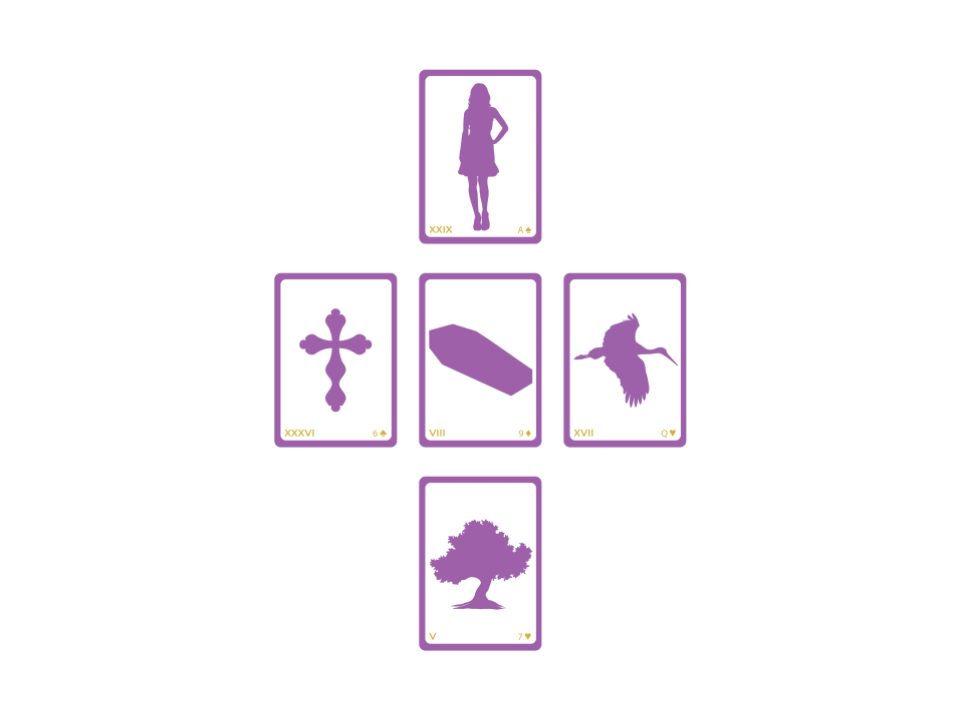
And the Coffin in the center here, is about endings, so the theme is about endings. Now notice that we drew this randomly but we could have also pulled it out of the deck consciously and placed it in the center.
So the central card represents a theme and oftentimes in Lenormand layouts because of their Tableau-style configuration.
In this simple cross, the theme is about endings and so what we would do, we would read this column and this row, and then the diamonds together, and possibly other ways of connecting the cards. Maybe in pairs, pair one (Woman + Tree) and pair two (Cross + Stork), just skipping the Coffin here.
Just in general, this is not really about interpreting a layout. We can see here that there's a necessary ending that sets us free, and that this doesn't seem to be going anywhere or that patience is needed before we get the green light to move forward.
The thing about the Cross here is that it seems to be a little bit out of our hands. We have to wait this out. And the thing about the Woman is that it can't be waiting for this person to come back. to get the green light from her.
So with the Coffin in the center here, the theme is either about an ending or a waiting time.
SIGNIFIER IN A SIMPLE PORTRAIT
Now, we can also use the use the signifier at the center of a portrait. I'm just going to put this one away. I'm going to put another card in the middle and I'm going to add corner cards to complete the portrait here.
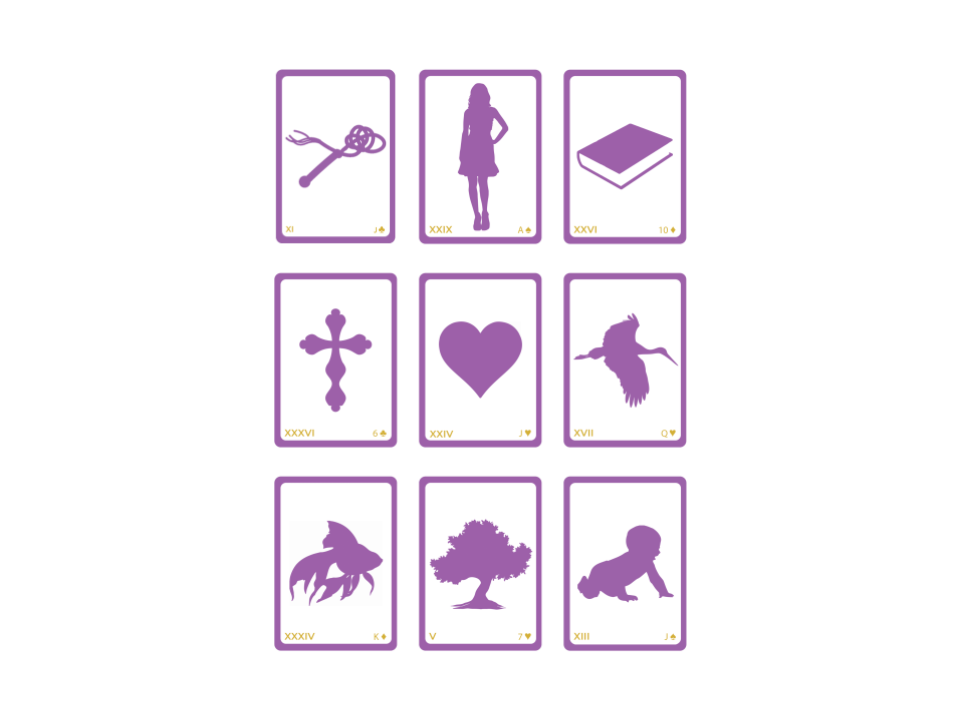 And with the Heart in the middle which came up in our initial examples. This has to do probably with love, happy emotions, or possibly because of the Jack of Hearts, it can represent someone.
And with the Heart in the middle which came up in our initial examples. This has to do probably with love, happy emotions, or possibly because of the Jack of Hearts, it can represent someone.
And with the Child here, it can mean a new relationship or possibly a crush. But with the Whip maybe there are some complications. So again, this is not about interpreting the layouts here, it's more about looking at the signifier.
In these last two examples (the simple cross and portrait), we randomly drew the signifier and we used it as the theme of the reading.
We go with the theme of the central card mainly when it's an open-ended question.
But if we had a specific question in mind, then what the central card does is it tells us what area to focus on within the context of our question or what is the main driver of the answer to our question.
SIGNIFIERS IN MULTI-QUESTION LAYOUTS
In general, when we talk about signifiers we usually draw it consciously out of the deck. And for this I find that multi-question readings are really the ones that benefit mostly from having a signifier.
A multi-question reading is several questions as part of one layout. And I offer this in my Private Reading Menu.
I do three- and five-multi questions, so three lines for three questions or five lines for five questions, and I'm going to lay this out in a minute, but I want to give you a real life example from several customers.
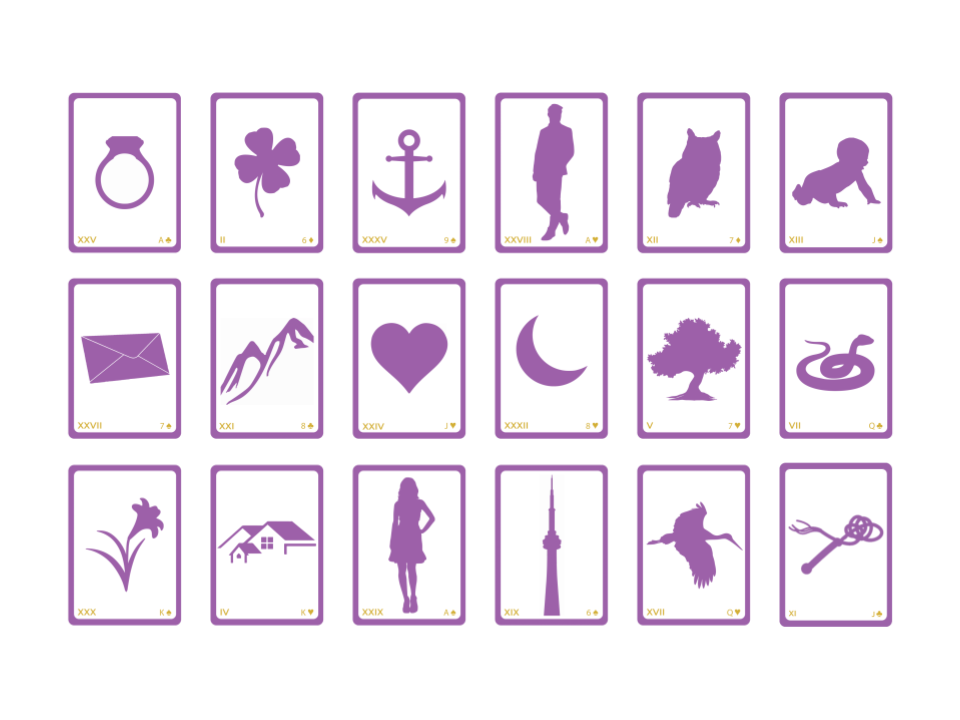
I'm just going to put several questions into one reading just to mix it up. So here are some questions that I have received for a private reading. It says - in love:
“Will I meet the one that is meaningful to me in a trusting and lasting relationship?”
This question is about love, so we could use the Ring to represent the question or we can use the Heart. You might also want to consider the Man or the Woman to represent this question if it is relevant, or if the your client prefers, because oftentimes the Man and Woman represent the other significant other of our readee.
But if you don't know the details of who's the Man and who's the Woman, and you don't think it's relevant, you might choose either the Heart or the Ring.
Personally, I would go with the Ring because the Ring is more about commitments than the Heart. That would be my personal preference.
Let's go for another question so we'll keep this one here. It says:
"Should I contact the person I met on the business trip but I haven't been in touch with that person since. Should I get in touch with this person?”
The signifier can be either the Bird like we suggested, or it can mean the Letter. I would think that the Letter makes more sense, I think, if you haven't been in touch with a person for a while, ever since that trip, then it makes more sense that you would write to them as opposed to pick up the phone and call them immediately. But it is also a better card of communication just in general.
What is the third question that we have? The third question I have from one of my previous clients is life path:
“Am I on the right track at work?”
For this question, it is very obvious to me that the Lily is the right card. So we've got the Lily which also came up in our example earlier. The Lily is a really good candidate as a signifier for a life path and a career question.
So this is how I do the multi-question readings:
I would represent each of the questions with a signifier card that aligns with the question and then, having shuffled my deck, I lay out five cards per question. And as you can see, every question has a line of five with a central card.
With the multi-question readings, the signifier is not in the central structure of the line.
It's not like the cross and the portrait. Instead, it is at the beginning of the line. And the line which is a line of five has its own central card. So I would read this line as an answer to this question.
It's handy to have a signifier card, especially when you have more questions, which I do with a five multi-question reading.
But it is not necessary to have, so signifiers are an optional thing, especially when they're drawn consciously - well, only when they're drawn consciously is it an optional thing.
I can read each of these lines and answer the question without having a signifier. In fact, when I get several questions that are focused on the same theme, I tend to remove the signifier because I have only one card to represent a signifier.
So if someone is asking about multiple relationships, and I have only the Ring to represent one relationship, then I tend to remove it because I have only one Ring, unless my client is able to specify different people which I can represent using different cards based on the pip of the card, like we explained. This is an option.
But in general if I have multiple questions about the same theme, then I tend to omit the signifier.
SIGNIFIERS IN A GRAND TABLEAU
Another place where we read signifiers and topic cards is in a Grand Tableau.
So I'm going to add a few more cards around these cards here, so we can fill up the space of my table almost into a shape of a Tableau, and then I want to show you how we can read the different topics.
Okay, so here is our Grand Tableau.
This is a Grand Tableau of Nines. There are two versions of the Tableau: There is a Grand Tableau of Nines which is the one where we have four rows of nine cards. And there's the Piquet Tableau, which is an eight by four, plus an additional line at the bottom that is made up of only four cards.
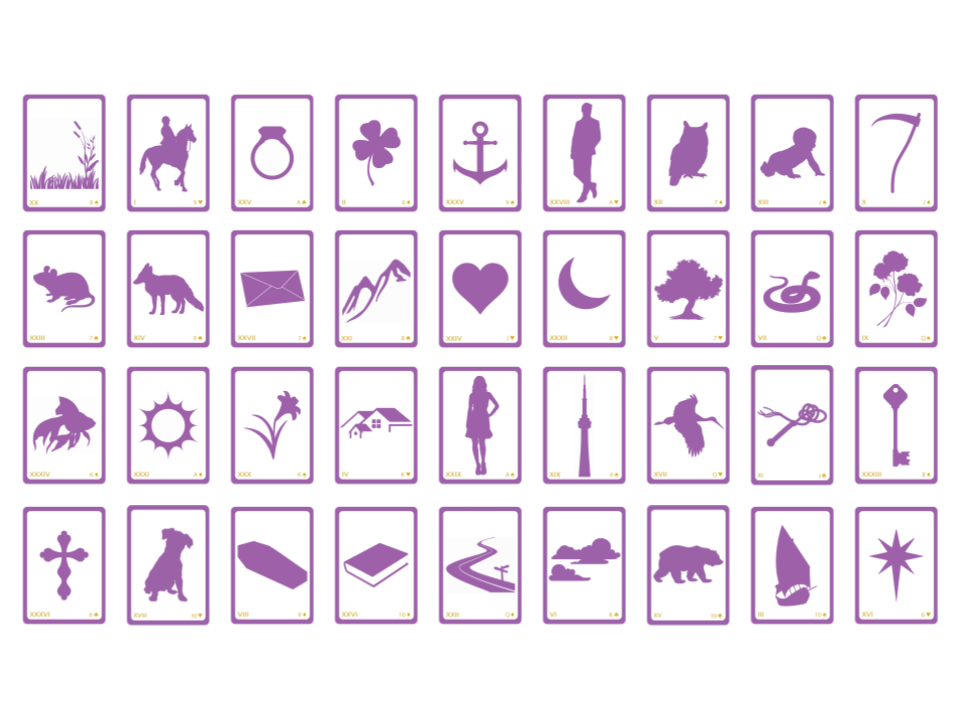
For this example, we have the Grand Tableau of Nines.
All 36 cards are on the table which means that all the topics that can be represented by Lenormand’s cards figure on the table.
What we do is we sit in front of a Tableau like this, and we look for the different topic cards, and we read the portrait around them, and this gives us an idea about what's going on in that area.
For example, we have the Letter. The Letter is here, it points to communications, and so when we look at the portrait around it, we get insights about what this communication is about. Here we have the Rider, Ring, and Clover.
We have the Rider, Fox, and Sun. Sun, Lily, and House, and Clover, Mountain, and House.
So there are different indications here. This one jumps out to me [Ring, Letter, Lily] - the central column - it points to a work contract. I like having the Fox in here because the Fox, like we said, can be a card of work.
With the Lily, and the this idea of a contract, this correspondence of the Fox, can maybe be pulled into the reading. The Rider with the Sun, is a really positive message. So this seems to be good news.
The Lily and House can point to the team on the job, and with the Mountain here, it can be a place abroad.
The Clover with the Sun, lovely. So the communication seems to answer a wish, it seems to be related to work, and can point to a place abroad - we have two travel cards. And it can also refer to our team on the job.
But of course, the House can also point to home and family, and with the Lily, it can point to our parents, elders, possibly our roots, so this is also a theme that can come into play in light of this communication.
This is a brief example. Again, this is not about doing a reading, it's more about illustrating how we use topics and signifiers.
What about home? Here is home and family, the House is the card of home and family. And then we can see that the portrait around it gives us indications.
With the Woman and Lily, it can point to our mother. With the Coffin and Lily, it can point to someone not feeling too well. And with the Letter at the top, maybe we need to get in touch and reach out to home, especially with the Book here. When I look at this arrow, the Coffin, Book and Road, maybe someone is going away or maybe we're leaving home. This can be a move.
And again we have the Mountain in here. It can be a travel element with the Road in this arrow. So you can see here how we're reading some cards around the House.
Let's look at another topic within the Grand Tableau. How about the Heart. The Heart is about positive relationships, happiness, and compassion. And I really feel that the Heart in this portrait is about relationships because notice that we have both the Man and the Woman around it.
Like I've said before, we have one Man and one Woman. If this is not what your relationship looks like, it doesn't have to be strictly a Man or a Woman. But because of their archetypal energies and represent symbolism, this is very much a combination that points to relationships.
Look at this arrow here (Clover, Woman, Man), very positive for a relationship with the Heart in the middle, the home (House), there could be intimate moments with this person, or there could be an opportunity to get closer.
The Mountain can mean a trip abroad. We have the beautiful Moon here, so you see different combinations point to positive relationships. And it's really the Man and Woman that bring out the Heart as indicating a relationship.
What other topics might we read? How about the Tree. The Tree is sometimes a reference to good health or health.
Some people read it as bad health, and I've had questions about this before. But I tend to read it as as good health and peacefulness and that sense of growth.
I also think the Tree is a good card for solitude in terms of its general meaning. But it's broadly a card of well-being. It can also call for patience and for being calm and letting things unfold. When we focus on this topic here that is the Tree, we look at these cards. We have some tricky cards around it. We have the Child, Snake, and Whip, and we have the Stork next to the Whip.
We also have the Bird, which can mean that there is some kind of revelation. And it has to do with this gentleman here.
Again, we're not really looking into the meaning of the cards, but just getting a general idea of how we can read around a topic card. And here it seems that we need to be calm in the face of some turbulence that is associated with this person.
Maybe there's a bit of a conflict or differences that come through. There's no need to jump the gun. We have the Tree before the Whip telling us to temper our response in the face of this.
So these are just examples. As you can see, we can pick any card in a Tableau, and interpret the portrait around it to get an indication about what's going on in this area, in this topic.
Like I said in the first part of this video, Signifiers Part One, you can do a Tableau and just look at the different topics and read the portraits around them. So if it intimidates you to do a reading of these long lines here, but you still want to do a Tableau, you focus on this topic technique within a Tableau.
Notice that when you are reading the portrait around a topic, you are reading a three by three by three square, you are reading three card lines. It's a really good way to immerse yourself in front of a Tableau without feeling overwhelmed by having to read these really long lines and long diagonals.
You can focus on the topic cards in a Tableau and you can do an open-ended reading for yourself and look at the different areas that are coming up for you in your life, and focus on the ones that matter to you, and read the portraits around them.
This is a legitimate technique with the Tableau. It is quite popular. And yes, you can do it in tandem with the other techniques, such as reading the rows and columns. But if you're still intimidated by these long lines. Then you can just focus on the topic technique of the Tableau.
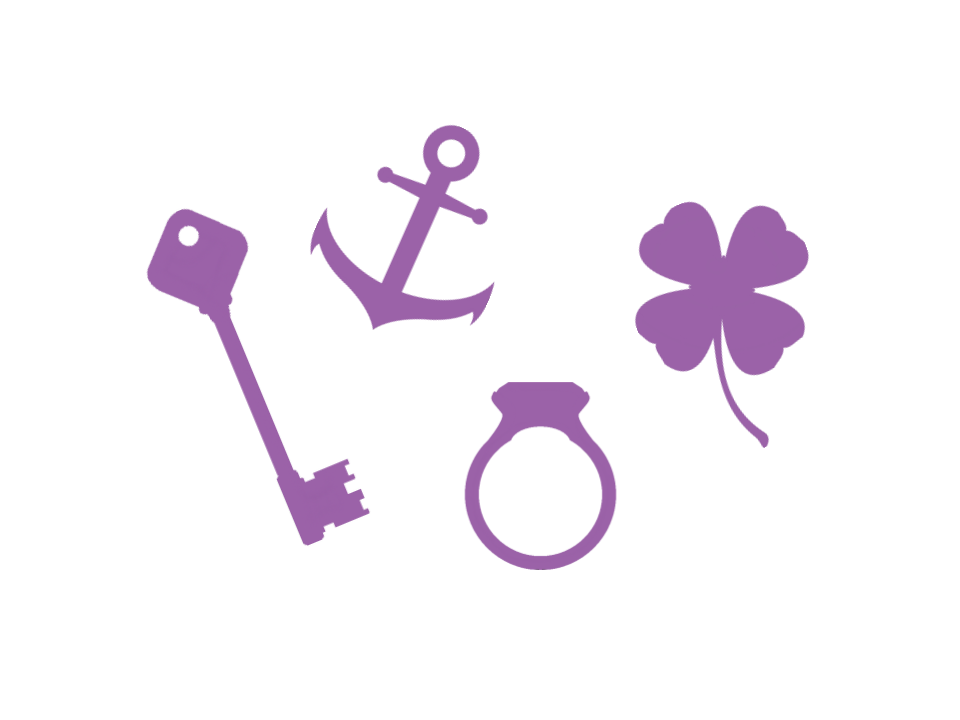
So this is how I wanted to illustrate the signifiers for you, in the different ways we can use the cards to represent signifiers, and in the different kind of layouts where we might use signifiers. I hope this has proved helpful to you.
Please let me know and leave me your comments and questions, I'm really looking forward to them. So until we meet again, thank you so much for watching. Keep me posted about your Lenormand practice and I'm looking forward to our next video together. Take very good care of yourself.
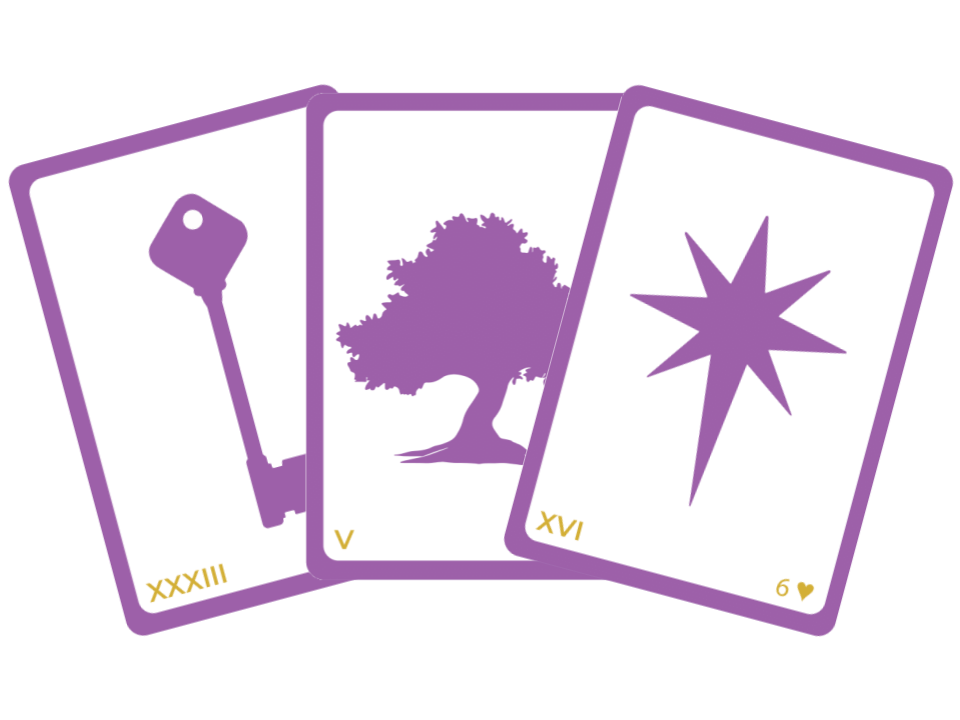
Want To Master Lenormand?
Lenormand Reader’s Certification Program is the only one of its kind, in size and in depth, to help you master the amazing Lenormand deck. This Program is filled with knowledge and practice accumulated through 20+ years of study and practice. It is organized into a real body of knowledge and delivered with best in class, online, on-demand video. Join the waitlist so you secure your spot when registration opens.
Join Lenormand Reader’s Certification Program
